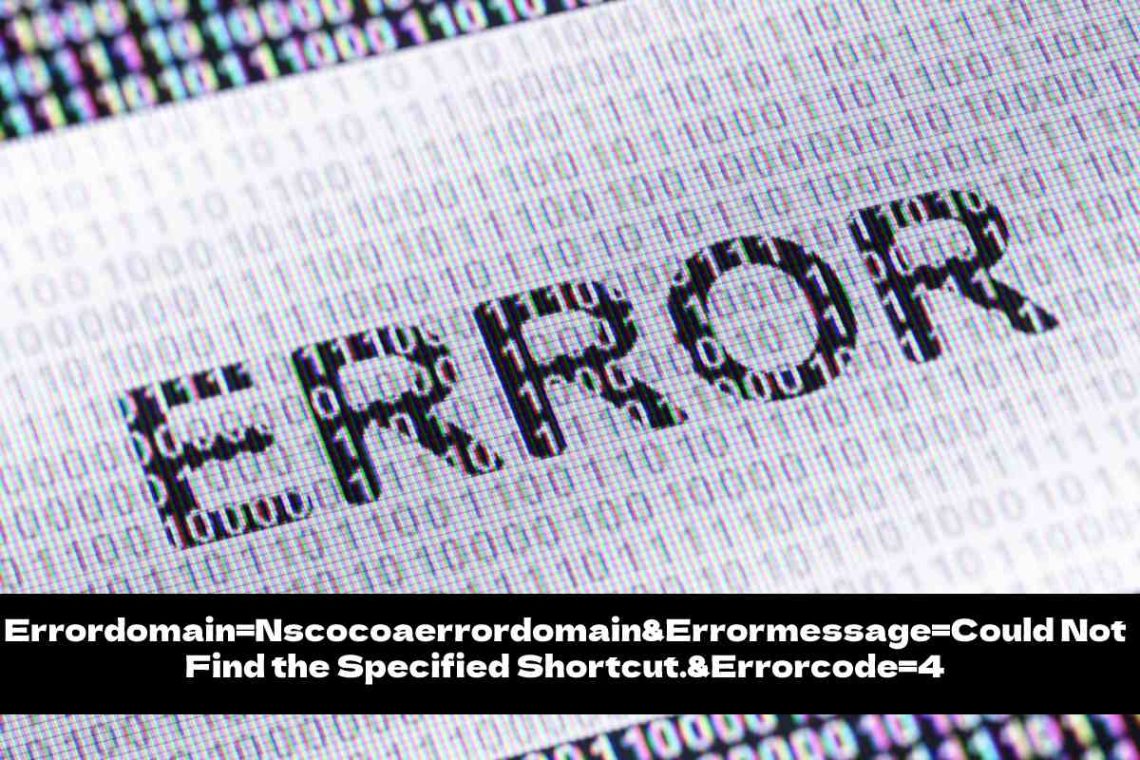Table of Contents
Introduction
Errordomain=Nscocoaerrordomain&Errormessage=Could Not Find the Specified Shortcut.&Errorcode=4 – You could run into perplexing issues and error messages when creating programs for macOS or other Apple platforms. “Errordomain=Nscocoaerrordomain&Errormessage=Could Not Find the Specified Shortcut.&Errorcode=4” is one example of such an error message. This post will explain NSCocoaErrorDomain in detail, explain the meaning of the error message, and look at how to fix and avoid issues of this kind.
What is NSCocoaErrorDomain?
The error domain NSCocoaErrorDomain is unique to Apple’s Cocoa framework, which is extensively utilized in creating macOS and iOS applications. It offers a consistent method for managing and conveying faults inside the Cocoa framework. NSCocoaErrorDomain is one of the error domains frequently linked to errors arising in Cocoa-based apps.
The purpose of NSCocoaErrorDomain is to handle various problems associated with the Cocoa framework, such as those arising from file system operations, data serialization, networking, etc. By grouping mistakes into distinct domains, developers may more quickly locate the error’s source and take the necessary steps to manage or fix it.
Understanding The Error – Errordomain=Nscocoaerrordomain&Errormessage=Could Not Find the Specified Shortcut.&Errorcode=4
Despite its mysterious appearance, the error message “ErrorDomain=nsCocoaErrorDomain&ErrorMessage=Could Not Find the Specified Shortcut.&ErrorCode=4” provides essential details about the problem. Let’s dissect it:
- ErrorDomain: This stands for the error domain, “nsCocoaErrorDomain,” in this instance. This domain is only for macOS apps that use Cocoa.
- ErrorMessage: Displays the error message “Could Not Find the Specified Shortcut,” as stated in the notice.
- ErrorCode: Contains the error code related to the problem. The error code in this instance is “4”.
Comprehending the constituents of the error message facilitates the identification of the issue and the selection of a suitable resolution.

The Reasons for the Error Message: Errordomain=Nscocoaerrordomain&Errormessage=Could Not Find the Specified Shortcut.&Errorcode=4
You could receive an error code for a variety of reasons. Typical reasons are:
Inaccurate program: Your program may be outdated, which could lead to conflicts and the error messages you see below.
- Files that show corruption: This error message could appear if there is damage to the file.
- Permission Problems: An error message could appear if the file or directory’s permissions are incorrect, along with their incorrectness.
- Malware or Viral Infections: Malware or viral infections can potentially corrupt system files, resulting in an error message.
- Hardware Issues: This error message may appear if your machine has hardware issues, such as a broken hard drive.
How to Fix Errordomain=Nscocoaerrordomain&Errormessage=Could Not Find the Specified Shortcut.&Errorcode=4
Upgrade Your Software:
These kinds of issues or mistakes could be brought on by outdated software. Go to the App Store and choose the “Updates” option to update your software. Should updates be provided?
- You can press “Update” to install them.

Corrupted Files: – Errordomain=Nscocoaerrordomain&Errormessage=Could Not Find the Specified Shortcut.&Errorcode=4
- Make sure there are no corruptions in your files. This error message could appear due to corrupted files on your PC. You must use Disk Utility to search for corrupted files. The Utilities folder contains the Disk Utility utility.
- Select “First Aid” from the “First Aid” menu after selecting your drive.
- Next, select “Run” to start the verification process.
- Click “Repair Disk” to resolve any problems that may arise.
- Erasure of files: An error may occur if the file linked to the shortcut is relocated or destroyed.
- Configuration issues: This error may be detected due to faulty configuration settings in the system or application.
- Data errors: A system’s corrupted data can lead to a mistake.
Verify the shortcut that you have specified.
- Begin by verifying which shortcut generated the error.
- Check to make sure the shortcut’s setup and name are accurate.
- Verify that your shortcut is free of errors and typographical issues.
Make Sure Permissions are Correct:
This error message could happen if a specific file or folder has the wrong permissions. Click on the folder or file you are concerned about to view permissions.
- To right-click a file or folder, select it.
- Next, choose Get Info.
- Ensure the permissions are set correctly by reviewing the Information box tab.
Check for Viruses or Malware:
System files may become impacted by malware or viruses, which could lead to an error message. A reliable antivirus program, like Malware Bytes or Norton, should be used for a malware or virus scan.
Verify Your Hardware:
Hardware problems on your system, like a failed hard drive, can display this error message. Examine any hardware problems using the Apple Hardware Test.
- To Test the Hardware,
- Close your system and reboot it while pressing the “D” key.
- Follow the screen instructions on how to pass the test.
Check for corrupted files: If the file you are attempting to open is corrupt, you may need to restore or repair it before opening it again. To fix or convert a backup copy to the original file, you can attempt to use an application.
Contact Support: You can try reading the instructions or giving the program or application’s support department a call if the issue continues to arise. They might be able to provide more help or information to help solve this problem.
Go Over Setting Configuration:
- Examine the software or system’s configuration settings where the problem occurred.
- Look for any inconsistencies or incorrect settings that might be causing the issue.
- Adjust the parameters as needed.
Conduct Data Integrity Tests
- Tests to verify the integrity of your data can help prevent potential issues and guarantee the security of your system.
- Utilize methods or instruments to identify and fix data corruption problems.
Backup and Restore
You may want to restore your system or application configuration to a time when the problem did not exist if you have a backup. It can fix issues relating to composition.
Get Professional Assistance
If, despite trying the previously suggested solutions, you are still unable to resolve the problem, you might want to seek assistance from a professional or expert with knowledge of the specific application or system causing the pain.
Conclusion – Errordomain=Nscocoaerrordomain&Errormessage=Could Not Find the Specified Shortcut.&Errorcode=4
Although receiving the error “errordomain=nscocoaerrordomain&errormessage=could not find the specified shortcut.&errorcode=4” can be annoying, fixing it is typically a simple task.
If you adhere to the previously mentioned criteria, you should be able to identify the problem’s root cause and then take the necessary action to fix it.
Please do not hesitate to contact the software or application’s support staff for further assistance if you still have problems.
Frequently Asked Questions
What is an Apple Development Framework?
An Apple development framework is a set of software tools, libraries, and APIs (Application Programming Interfaces) provided by Apple Inc. to facilitate the development of applications for their platforms, such as macOS, iOS, watchOS, and tvOS.
What is an Application Bug?
An application bug, a software bug, or a programming bug refers to an error, flaw, or unintended behavior in a software application. It is a deviation from the expected or intended functionality of the application.
Does the error “could not find the specified shortcut” occur only in the case of the Cocoa framework?
The error message “could not find the stated shortcut” is not specific to the Cocoa framework. Depending on the context, it is a generic error message that can occur in various software systems.
How to correct the extension errors?
To correct extension errors, you must ensure that the file postponement matches the file type or format.
How do you identify the correct file extension?
To identify the correct file extension, look into the file’s documentation or through other reliable sources.

